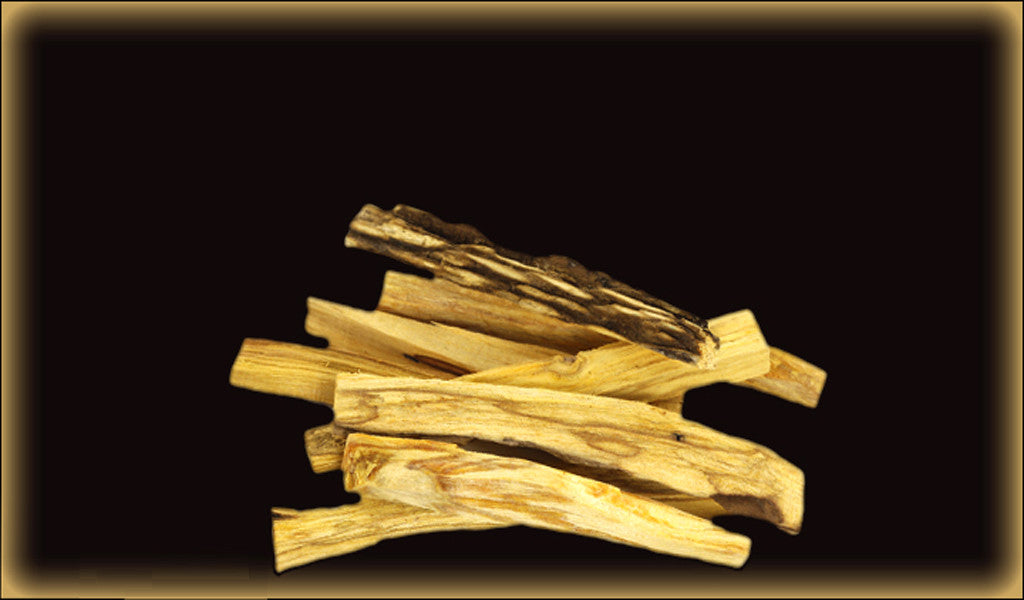Those who know about it, can’t get enough of it. Oh sure, ‘it’ is a tree, but it’s unlike most in a truly mystical way. Palo santo is its name and it grows in the Amazon rainforest, lives in a harem that can only be described as truly grounded; and has a spirit that heals, purifies and commands respect. Whether you burn it to envelop yourself in its aroma or store it in your closet, you will benefit from the many positive qualities that it freely shares.  Palo Santo Map[/caption] Palo santo has smooth greyish bark and lustrous green leaves. It is native to the Pacific coast of South America, and especially common in Peru and Ecuador. Palo santo belongs to the same family as myrrh and frankincense and, like its more famous cousins, is often burned in ceremonial settings. Its wood has a pleasant soft scent often described as having notes of pine, mint and lemon. In Latin, palo santo is called bursera graveolens, or “a bag of oil,” and rightly so! Studies show that its heartwood contains 114 different essential oils, including those present in medicinal plants such as mint, rosemary, lavender and eucalyptus.
Palo Santo Map[/caption] Palo santo has smooth greyish bark and lustrous green leaves. It is native to the Pacific coast of South America, and especially common in Peru and Ecuador. Palo santo belongs to the same family as myrrh and frankincense and, like its more famous cousins, is often burned in ceremonial settings. Its wood has a pleasant soft scent often described as having notes of pine, mint and lemon. In Latin, palo santo is called bursera graveolens, or “a bag of oil,” and rightly so! Studies show that its heartwood contains 114 different essential oils, including those present in medicinal plants such as mint, rosemary, lavender and eucalyptus.
TREE SPIRIT
For centuries, the Incas used palo santo to cure different ailments, both bodily and spiritual. When they taught Spanish monks about this tree, the religious men were so amazed at its wonderful properties that they named it palo santo, which translates to “holy wood” or “the wood of the saints.” And, indeed, they could not have found a more appropriate name: as a true saint, palo santo generously grants both physical healing and spiritual elevation to whoever comes in contact with it.
 The most amazing feature of palo santo, perhaps, is its spiritual properties. South American shamans have used it for ages to purify the space, ward off evil spirits, promote peace and enhance meditation. When burned, it produces white smoke that has a mild, invigorating scent and can be used to smudge (a.k.a., a smoke bath) houses, offices and even people for its purification effect. It is a good, though much more rare, alternative to sage, which is also 100% natural and used to clear negative energy.
The most amazing feature of palo santo, perhaps, is its spiritual properties. South American shamans have used it for ages to purify the space, ward off evil spirits, promote peace and enhance meditation. When burned, it produces white smoke that has a mild, invigorating scent and can be used to smudge (a.k.a., a smoke bath) houses, offices and even people for its purification effect. It is a good, though much more rare, alternative to sage, which is also 100% natural and used to clear negative energy.
It is said that an attraction to the scent of palo santo is a sign of spiritual purity. But don’t be discouraged if you are not initially attracted to its aroma or even feel a surprising discomfort with it at first! This is all part of the purifying process. Through repeated experiences with its spiritual fragrance, palo santo will surely work its magic on you and you will soon find its aroma simply irresistible.
PALO SANTO HAREMS
Nowadays, shamans from indigenous cultures such as the Aymara and Quechua continue to use palo santo in their religious ceremonies and purification rituals. They treat this tree as a living entity and pray to it for healing. They also know how to distinguish between the male and female trees, and say that palo santo trees grow in families of one male and eight females. The lifespan of an average female tree is 40-50 years, and its wood is yellow, solid and heavy. Male trees, on the other hand, can live up to 200 years and their wood is white, hollow, fragile and light.
PALO SANTO GIVES, BUT ONLY WHEN HARVESTED SUSTAINABLY
Shamans believe that palo santo has a very special spirit that should be treated with utmost respect. This is why palo santo trees should never be cut down for their wood. The tree must first die naturally and rest on the forest floor for at least three years before its wood can be harvested. Today, the ancient shamanic wisdom is confirmed by science, as studies show that oil extracted from felled trees does not possess all of the therapeutic qualities possessed by those that fell naturally.
PALO SANTO AS A HEALER
 Palo santo wood has numerous uses, from mundane to medicinal and even spiritual. In Latin American countries, its smoke had been widely used as a mosquito repellent until it became almost entirely replaced by commercial chemical substances. Now, however, its more exciting qualities come to the fore, and palo santo is rapidly gaining recognition as a medicinal plant, both in the scientific world and among the general public. Sticks of palo santo wood can be boiled in hot water to make tea, which is believed to be especially good for common cold, flu and anxiety. Another popular product is palo santo essential oil. Golden yellow in color, it has a fresh citrusy scent and can be either worn as a fragrance, used in an oil diffuser or taken as a natural antibiotic.
Palo santo wood has numerous uses, from mundane to medicinal and even spiritual. In Latin American countries, its smoke had been widely used as a mosquito repellent until it became almost entirely replaced by commercial chemical substances. Now, however, its more exciting qualities come to the fore, and palo santo is rapidly gaining recognition as a medicinal plant, both in the scientific world and among the general public. Sticks of palo santo wood can be boiled in hot water to make tea, which is believed to be especially good for common cold, flu and anxiety. Another popular product is palo santo essential oil. Golden yellow in color, it has a fresh citrusy scent and can be either worn as a fragrance, used in an oil diffuser or taken as a natural antibiotic.  Studies show that palo santo oil contains numerous chemical components that can be instrumental in treating common colds, influenza, rheumatism, arthritis, arthrosis, depression and even cancer. Its main constituent is limonene, a chemical substance present in citruses that has anti-stress and sedative properties. Palo santo essential oil is also used in curative cosmetics to produce massage oils and topical creams that can relieve muscle and joint pain.
Studies show that palo santo oil contains numerous chemical components that can be instrumental in treating common colds, influenza, rheumatism, arthritis, arthrosis, depression and even cancer. Its main constituent is limonene, a chemical substance present in citruses that has anti-stress and sedative properties. Palo santo essential oil is also used in curative cosmetics to produce massage oils and topical creams that can relieve muscle and joint pain.
HOW TO BENEFIT FROM PALO SANTO
For spiritual and cleansing purposes, palo santo usually comes in the form of sticks but can also be found in cone incense. Sticks can either be kept in a satchel and stored in a wardrobe, or burned to release the wood’s aromatic oils and healing properties. Cone incense is made of tiny pieces of palo santo and mixed with other natural ingredients, such as various wild herbs, spices and tree resins to produce aromatic blends for different intentions.








0 comments